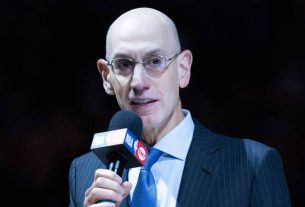Unable to come to terms on a one-year salary for the upcoming season, McNeil and the Mets appeared headed toward an arbitration hearing. He’d filed for a $7.75M on the heels of his first National League batting title in 2021, whereas the Mets had countered with a $6.25M figure. Those sums can now be thrown out, as McNeil’s final two arbitration years are locked in. If we count 2023 at the $7M midpoint of those two sums and figure McNeil could’ve earned anywhere from $12-13M in what would’ve been his final arbitration season, the Mets are guaranteeing somewhere in the vicinity of an additional $30M to lock in two more free-agent seasons and secure a reasonably priced club option on a third free-agent year.
McNeil, 31 in April, is now locked in through at least his age-34 campaign and possibly his age-35 season. He’s fresh off one of the finest seasons of his career, having turned in a .326/.382/.454 batting line with nine home runs, 39 doubles, a triple and four stolen bases in 589 plate appearances. Unsurprisingly, that season earned him a second career All-Star nod and won him Silver Slugger honors in the National League — his first such award.
McNeil was one of the toughest strikeouts in the Majors, fanning in a career-low 10.4% of his plate appearances. He’s never walked much and didn’t change that in 2022 (6.8%), but it’s difficult to argue with the results. McNeil benefited to an extent from a career-high .353 average on balls in play, but even if that mark regresses toward the .324 mark he carried into the 2022 season, his bat-to-ball skills and penchant for finding the gaps will allow him to remain the well above-average hitter he was for the majority of the 2018-21 seasons.
The 2022 season was also very arguably the finest defensive season of McNeil’s career. Each of Defensive Runs Saved (3), Ultimate Zone Rating (3.5) and Outs Above Average (7) pegged him as a strong handler of the glove at second base. He also logged some brief time in the outfield corners (278 innings) and drew average or better reviews for his work there, and he even chipped in a lone inning at third base for good measure. Second base will continue to be his primary home on the diamond, but McNeil has shown in the past that he’s a capable third baseman, left fielder, or right fielder, which only adds to his value for the Mets.
Of course, since we’re discussing the Mets, the financial ramifications of the contract extend well beyond the $50M that McNeil himself will receive. The Mets are already over the fourth and final luxury-tax barrier this season, meaning any dollars they spend are taxed at a 90% clip. Had McNeil won his arbitration hearing and secured a $7.75M salary, that would’ve meant the Mets would’ve paid $6.975M in taxes on his salary — bringing the total expenditure to $14.725M. Instead, the Mets will now be taxed based on the $12.5M average annual value of McNeil’s contract. That means they’ll pay $11.25M in taxes on McNeil’s contract this year — an increase of $4.275M over what they’d have paid him had he won an arbitration hearing.
There’s some down-the-road tax benefit to extending McNeil — even beyond the obvious value in keeping an excellent player at a reasonable rate for the next half-decade. Had McNeil won an arbitration hearing next month — and coming off a batting title, he’d have had a strong case — he’d have landed that $7.75M salary. With another strong season, he’d quite possibly have been in for a raise beyond the $12.5M AAV of his current contract in his final arb season, when the Mets will likely again be in the top tier of luxury penalization (with overages being taxed at a 110% clip). The extension, then, could wind up saving the Mets $1M or so of their luxury ledger for the 2024 season — assuming McNeil has a healthy and productive 2023 campaign.
Setting aside any such minutiae, the primary benefit to the Mets is simply keeping a two-time All-Star and paying an annual rate that, with good health for McNeil, will likely clock in below his true open-market value by the time the 2024-25 offseason rolls around. There’s certainly some risk for the Mets, as one need only look at McNeil’s pedestrian .251/.319/.360 batting line from 2021 to see that his lack of power (outside of the juiced ball campaign in 2019) leaves him with a fairly tepid floor. The Mets already had control over McNeil’s age-31 and age-32 seasons, and it’s always possible that preemptively buying out a player’s age-33 through age-35 seasons could look regrettable in hindsight.
That said, the aforementioned ’21 campaign is the lone below-average offensive season of McNeil’s career, and his contact skills and defensive aptitude at multiple positions figure to make him a perennially useful player even into his mid-30s. It’s not realistic to expect him to replicate his 2022 production in the years ahead, but there’s little reason to think this deal will turn into some form of egregious misstep, either.
McNeil now joins Max Scherzer ($43M), Justin Verlander ($43M), Francisco Lindor ($34.1M), Brandon Nimmo ($20.5M), Starling Marte ($20.75M), Edwin Diaz ($21.25M), Kodai Senga ($15M), Jose Quintana ($13M) and Tomas Nido ($2.1M) as players locked into their 2024 salaries.
Assuming an even distribution of McNeil’s salary, that’d come out to just over $225M guaranteed to 10 players, with another four club options (Mark Canha, Eduardo Escobar, Brooks Raley, Darin Ruf), two player options (Omar Narvaez, Adam Ottavino) and a nine-player arbitration class headlined by Pete Alonso all potentially adding to the bill.



